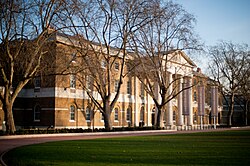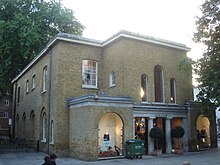| Duke of York's Headquarters | |
|---|---|
| Chelsea, London | |
 The Duke of York's Headquarters in December 2009 The Duke of York's Headquarters in December 2009 | |
 | |
| Coordinates | 51°29′26″N 0°09′32″W / 51.4906°N 0.1589°W / 51.4906; -0.1589 |
| Type | Drill Hall |
| Site history | |
| Built | 1801 |
| Built for | War Office |
| Architect | John Sanders |
| In use | 1801–present |
The Duke of York's Headquarters is a building in Chelsea in the Royal Borough of Kensington and Chelsea, England. In 1969 it was declared a listed building at Grade II*, due to its outstanding historic or architectural special interest.
History

The building was completed in 1801 to the designs of John Sanders, who also designed the Royal Military Academy Sandhurst. It was originally called the Royal Military Asylum and was a school for the children of soldiers' widows. In 1892 it was renamed the Duke of York's Royal Military School. In 1909, the school moved to new premises in Dover, and the Asylum building was taken over by the Territorial Army and renamed the Duke of York's Barracks in 1911. During the First World War it was the headquarters of the 18th (County of London) Battalion, London Regiment (London Irish Rifles) and of the Middlesex Yeomanry.
During the Second World War, the courts martial of German spies, Josef Jakobs and Theodore Schurch, (both tried under the Treachery Act 1940) were both conducted in the building.
On 20 September 1973 a Provisional IRA bomb exploded at the barracks injuring five people, three civilians and two soldiers, at which time it was the headquarters of the 14th Parachute Brigade (TA).
In 1980 the building was extensively restored and renovated, with the £1.5 million programme being carried out by Donald Insall Associates. At that time the building served as the Headquarters for the Territorial Army in Greater London, and as the home of Territorial units 144 Parachute Field Ambulance RAMC(V), 257 (Southern) General Hospital RAMC, 21 Special Air Service Regiment (Artists), and companies of 10th Battalion, Parachute Regiment and the London Irish Rifles. In addition, it served as the headquarters of the Royal Corps of Signals and First Aid Nursing Yeomanry, and as the home of the Coldstream Guards Band, and a Light Aid Detachment of the Royal Electrical and Mechanical Engineers. It also housed the offices of the RAF Escaping Society, the Army Historical Association, the Army Benevolent Fund, and the Soldiers, Sailors and Airmen's Families Association.
On 16 March 1992, Jack the Ripper Stalks His Victims, the first collection by British designer Alexander McQueen, was produced at the Duke of York's Barracks, as the thesis collection for his master's degree in fashion at Central Saint Martins (CSM) art school.
The site was sold to Cadogan Estates by the Ministry of Defence, with initial proceeds of £66 million received in 2000 and a further £28 million when the site was vacated in 2003. Cadogan has redeveloped the site with Paul Davis and Partners as Duke of York Square. The development includes a public square, upmarket housing and retail outlets, and part of it has been let as new premises for the Saatchi Gallery, which relocated there in 2008.
Hill House School, a prep school based in and around the Royal Borough of Kensington and Chelsea, uses the field of the Barracks for regular 'games' (sports and activities practices) and for their annual end-of-year 'field day'. Garden House, another prep school based in the Royal Borough, occupies the Cavalry House, part of the Duke of York's Headquarters on Turks Row, which became a grade II listed building in July 1998.
References
- ^ Historic England. "Duke of York's Headquarters (Territorial Army), Kensington and Chelsea (1266717)". National Heritage List for England. Retrieved 19 March 2023.
- Cherry, Bridget; Pevsner, Nikolaus (1991). London 3: North West. London: Penguin Books. p. 565. ISBN 0-14-071048-5.
- ^ "Court Martial of Josef Jakobs held at Duke of York Headquarters, Chelsea". josefjakobs.info. 14 March 2014. Retrieved 12 January 2017.
- "The London Regiment". The Long, Long Trail. Retrieved 27 May 2014.
- "1st County of London Yeomanry (Middlesex, Duke of Cambridge's Hussars) at regiments.org by T.F.Mills". Archived from the original on 15 July 2007. Retrieved 26 December 2017.
{{cite web}}: CS1 maint: bot: original URL status unknown (link) - "5 Injured in London as Bomb Goes off in Army Barracks". The New York Times. 21 September 1973.
- Long, Christopher (1980). "Like Lifting The Lid Off a Beehive". christopherlong.co.uk. Retrieved 12 January 2017.
- "Jack the Ripper Stalks His Victims five-piece pattern for pointed front ribboned collar 1992 Graduate Collection". RR Auction. Archived from the original on 7 October 2023. Retrieved 5 October 2023.
- "Marching To A New Future – Duke of York's Headquarters" (PDF). Defence Estates. 2000. Archived from the original (PDF) on 7 June 2007.
- "Duke of York Square: Royal Borough of Kensington and Chelsea". Commission for Architecture and the Built Environment. Archived from the original on 25 November 2010.
- "Saatchi gallery moves to new home". The Guardian. 2 September 2008. Retrieved 27 October 2019.
- "£14,000-a-year school attended by Prince Charles branded inadequate by Ofsted". Evening Standard. 11 March 2015. Retrieved 27 October 2019.
- "Garden House School – planning application" (PDF). Royal Borough of Kensington and Chelsea. 10 June 2004.
- "Garden House School". Building Images.co.uk.
- "Cavalry House, Duke of York's Headquarters, Kensington and Chelsea". British Listed Buildings. Retrieved 12 January 2017.